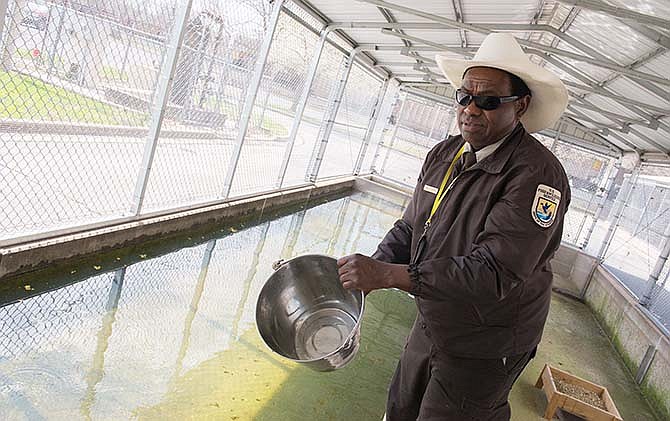NEOSHO, Mo. (AP) -- As hatchery manager David Hendrix walked across the concrete blocks in the raceways at the Neosho National Fish Hatchery, a school of fish, each just a couple of inches long, swam by. Just visible beneath the glare of the afternoon sun on the green-tinted water, they darted away from the sound of nearby footsteps.
In the next couple of months, those Topeka shiners are expected to start spawning, using the wooden boxes filled with gravel set up in their new habitat.
The fish are newcomers to the Neosho National Fish Hatchery, brought in as part of a partnership among agencies to help build the population of the endangered species back up and help stock the fish to a sustainable level in the wild.
"We just want it (the hatchery) to live up to its name and reputation and capability, and by being able to help out in this effort with the Topeka shiners . we're helping to meet a need," Hendrix said.
About adult 200 Topeka shiners arrived last month at the Neosho hatchery and were placed in their new habitat. Water trickles through the raceway to simulate a pond environment, hatchery lead fish biologist Jaime Pacheco said. The fish are fed flake food, supplemented with adult brine shrimp, Hendrix said.
The wooden boxes have been set up throughout the space to serve as nests, and plans are in the works to replace some of the metal panels on the roof with clear heavy-duty plastic so the sunlight can heat the water and help it get to the right temperature for spawning, Hendrix said.
That's expected to start when the water temperature hits 72 degrees. The spawning season lasts eight to 10 weeks, and a single spawning produces 150 to 800 eggs, depending on the size and condition of the female, according to a brochure from the Neosho hatchery.
Key to that process will be orange-spotted sunfish, which are expected to arrive at the hatchery in April, Hendrix said.
The two species maintain a symbiotic relationship in which the male sunfish guard the nest, using its tail to keep sunfish eggs oxygenated and silt-free. The male shiner waits along the outside edge of the space, allowing the female access to the nest where they spawn. The male sunfish ends up protecting both sets of eggs, according to the hatchery workers.
When the sunfish arrive, they'll be introduced to the raceway with the Topeka shiners. Once the eggs hatch, the fry will be moved to a nearby space, where they'll be fed and allowed to grow, Hendrix said.
"We're here to propagate them, reproduce them, here and continue to stock them at levels until we get a sustainable level out in the wild," Hendrix said, "and then once we reach a sustainable level of where they can fend for themselves, then we will pull back."
The Topeka shiner was listed as a federally endangered species in 1998. The species needs cold, clear water, and its decline has been connected to changes in water quality, loss of habitat, pollution, climate change, and urban and rural development, according to the hatchery.
In November, the Neosho hatchery, the Columbia (Missouri) Ecological Services Field Office and the Missouri Department of Conservation entered into an agreement to bring the shiners to the Neosho site, according to the U.S. Fish and Wildlife Service.
The adult shiners at the hatchery will be kept a couple of years for breeding, Hendrix said. The fish have a life span of about three years, and the key part of the plan is to hatch new fish and stock them into the wild. Fish born at the hatchery will be reintroduced into the wild in northern Missouri, he said.
Hendrix said he expected the project to continue over the next few years as the hatchery works with the Missouri Department of Conservation to re-establish the shiners in their normal range, The Joplin Globe (http://bit.ly/1y5p4tY ) reports.
"Our job is to build those numbers back up again," he said.
Shiners thriving in the wild would be an indicator of good water quality and ecosystem health, Pacheco said.
Though this is the first year of caring for the Topeka shiners, Pacheco is hopeful the program will stay at the hatchery and serve as a way for it to be more involved with endangered species.
"I think it's one of those programs that we're going to be able to continue year after year," he said.
The Topeka shiner has historically been distributed across portions of Missouri, Kansas, Nebraska, South Dakota, Iowa and Minnesota, according to the Neosho National Fish Hatchery.


